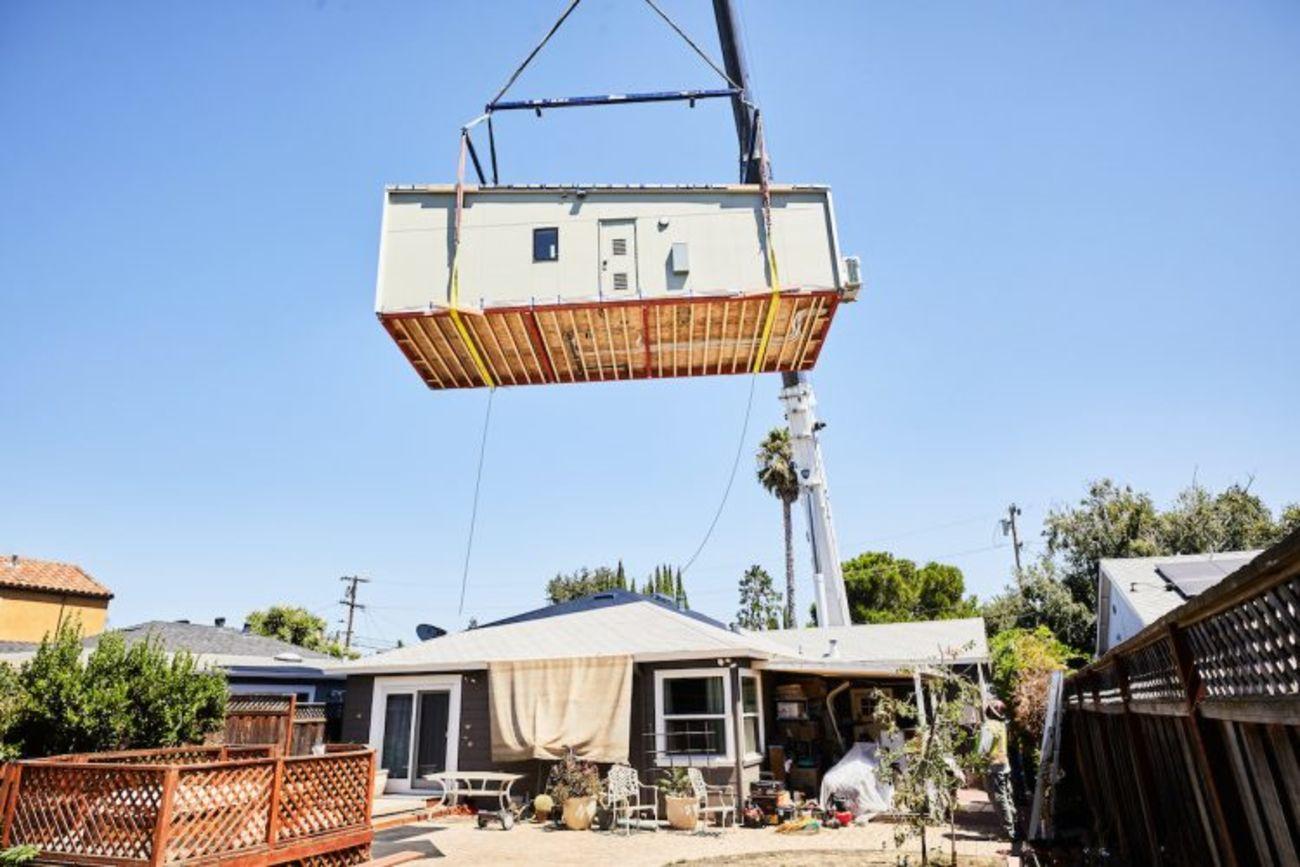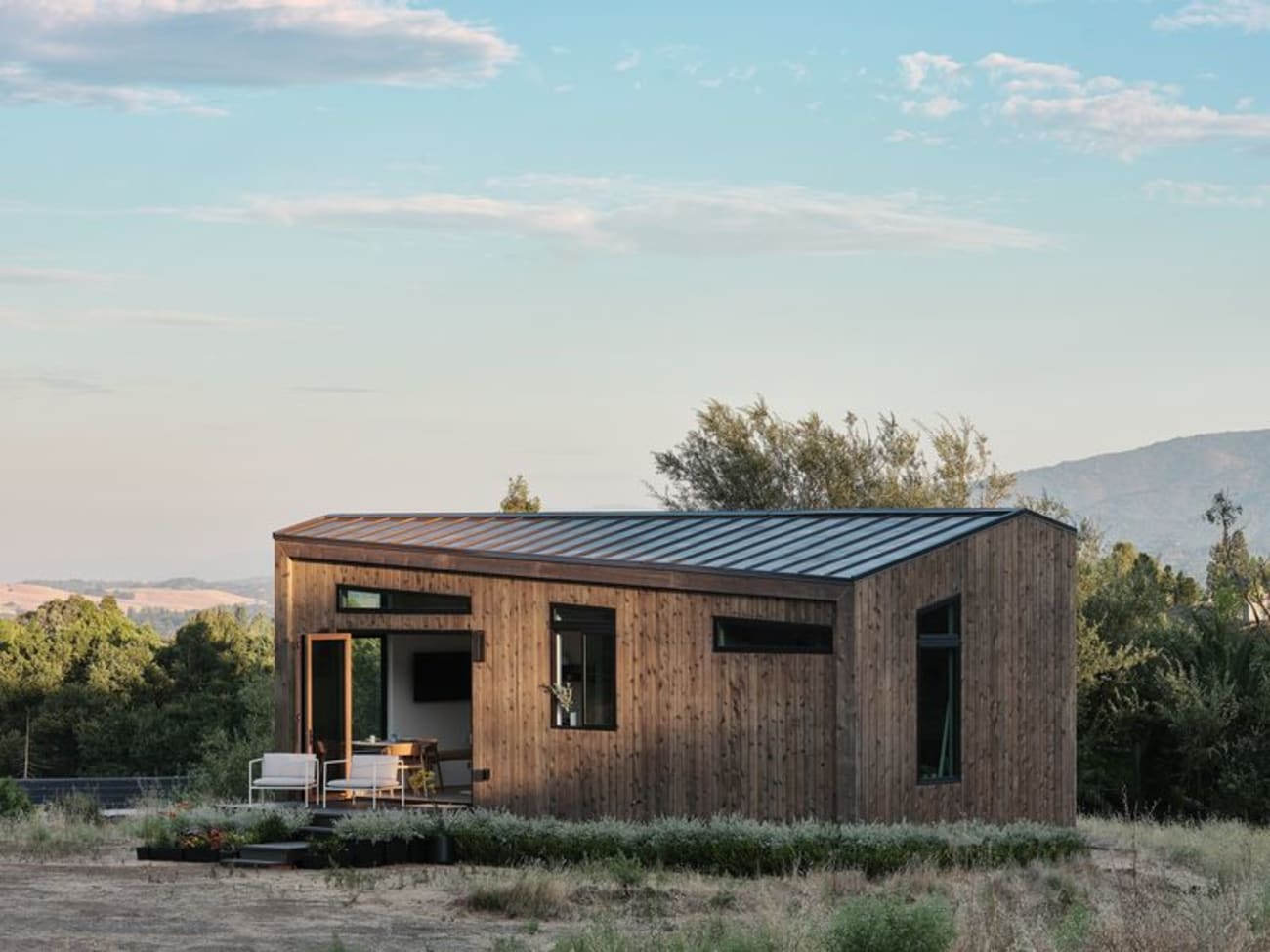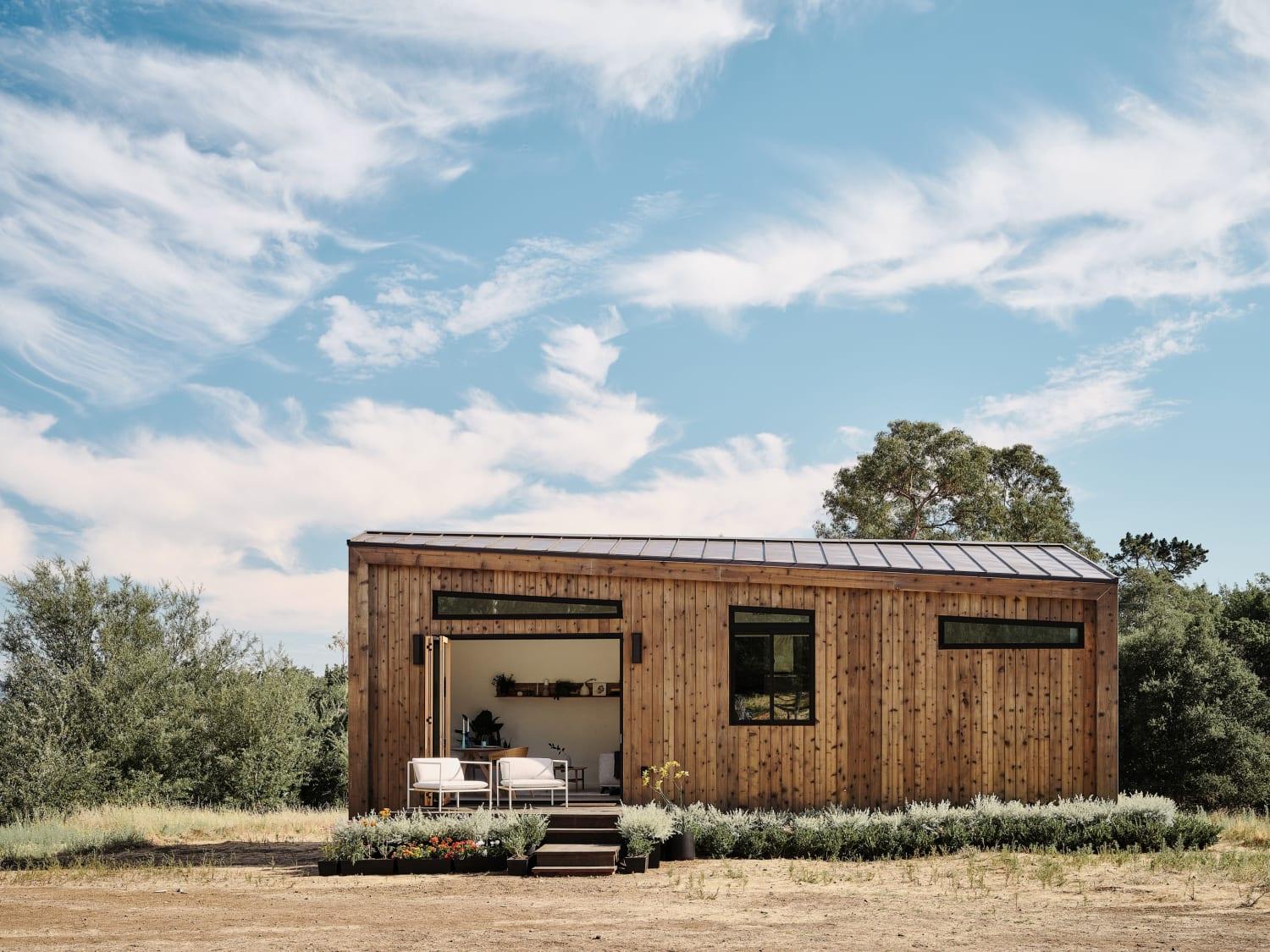How California Set Off a Backyard Apartment Boom

Bloomberg City Lab
Kriston Capps

Now that they’re fully legal, backyard homes are big business in California.
For years, permitting figures languished for granny flats, garage apartments and other types of accessory dwelling units, or ADUs, thanks to local restrictions that forced homeowners to submit to cumbersome discretionary approvals before local boards. Back in 2016, California passed a state law that required cities to ease these regulations and grant permits by set standards. Two more bills that followed in 2017 relaxed the rules around ADU construction. That’s when backyard apartments took off.
Four years later, ADUs account for a growing share of homes built across the state. California homeowners built some 12,000 backyard flats in 2019 — more than double the number permitted just two years earlier and a ten-fold increase since the state passed its preemption laws. Unlike other categories of housing in California, the numbers for new permits for ADUs are rising — with growth likely to continue thanks in part to efforts by local governments to help them go up quickly. In some cases, very quickly.
One Bay Area company, Abodu, boasts that it can deliver a backyard flat in a month’s time. Abodu builds pre-fabricated ADUs that are assembled on site, an approach that the company says brings down both the cost and time for construction. Its smallest offering, a 340-square-foot studio, starts at $189,000 — significantly cheaper than a similar stick-built house, according to CEO and co-founder John Geary. For select cities in California, Abodu promises that it can finish an ADU, from permitting through construction, in as little as 30 days.
“There’s a meaningful amount of housing units being put into neighborhoods that were traditionally very low-density, single-family neighborhoods as a result of that state legislation,” Geary says. “People are looking for ways to get this done efficiently, low stress and fast.”When California first eased restrictions on these homes, few “pure-play ADU suppliers” were operating in the state, Geary says.Instead, most ADUs were custom-built by contractors who did additions and kitchen and bath remodeling projects, or by custom homebuilders. Choices were limited for homeowners, who could either go with a company that had little experience doing ground-up construction or overpay an experienced contractor for a less-than-full-sized job. The founders of Abodu decided to couple pre-fabricated modular construction with a master file — referring to the pre-approved structural drawings that residential single-family home developers file with planning offices in order to pump out houses in subdivisions.She describes her dream of pre-approved, pre-fabricated backyard flats as “Amazon Prime for housing.”
Abodu is one of seven pre-approved vendors for ADU construction in San Jose, which means homeowners shopping for a granny flat can pick one of three Abodu designs and get a building permit in a matter of hours — a process that might otherwise take four to six months for a custom construction job. The homes are then built at a network of modular construction factories in Idaho, Utah and Washington.
The streamlined process stands in stark relief with building full-sized housing in the Bay Area. While Northern California remains the most expensive and unpredictable place to build new housing in the world, California homeowners are themselves erecting backyard homes by the thousands, and at a brisk clip. “Californians are really comfortable with incremental change to the West Coast suburban form,” writes Kim-Mai Cutler, a partner at Initialized, a venture capital firm and an Abodu investor.
Some cities are taking the lead to facilitate new backyard flats. Los Angeles, for example, launched a new ADU Standard Plan Program earlier this month to fast-track approvals for more than a dozen designs for backyard buildings. The city tapped prominent and promising architecture firms to supply the templates, among them , is to “turn it into an approval that is over-the-counter.”
Cutler puts it another way: She describes her dream of pre-approved, pre-fabricated backyard flats as “Amazon Prime for housing.”
 Accessory Dwelling Units Abodu’s one-bedroom option features Scandinavian-inspired design by the U.K.–based studio Koto
Photographer: Joe Fletcher/courtesy of Abodu
Looser restrictions on backyard apartments arrived just in time before the pandemic. Amid the lockdowns, economic uncertainty and supply-chain snafus, construction levels for 2020 are unlikely to set any records. Data on new housing starts during the pandemic aren’t available yet, but ADUs could be a rare bright spot in California and a few other places. Many well-off homeowners, especially remote workers desperate for office space, upgraded their homes with backyard structures in 2020.
“There are many reasons to think that ADU construction has picked up in the last year and will continue to pick up,” says Karen Chapple, professor and chair for the department of city and regional planning at the University of California-Berkeley. “The most obvious is interest in remote work and the realization that many single-family homes are not set up well for home offices or multiple home offices.”
Social isolation and safety fears in assisted-living facilities may have persuaded some households who were thinking about eventually building an in-law apartment for their aging parents (or themselves) to move their plans forward. Families who were frustrated that grandparents couldn’t see their grandchildren may have decided, “Let’s build the in-law finally,” Chapple says.
But most ADUs in fact serve as rental housing. A forthcoming report by Chapple based on a survey of 800 California homeowners who built ADUs finds that about half (51%) serve as income-generating rental units. Just a fraction (16%) went to a relative of the homeowner. Only a few backyard apartments (8%) wind up being used for short-term rentals such as Airbnb. Singles and couples account for most ADU occupants in California (86% in the survey); school-aged children (11%) and senior citizens (15%) represent fairly small slices of this population.
Pandemic aside, the trend in California is similar to the rise of ADUs in Portland, Oregon. Deregulation helped them take off. So did a snowball effect that Chapple describes as a “familiarity factor”: Seeing backyard units go up makes residents and neighbors who aren’t necessarily considering them feel more comfortable with them, which in turn makes it easier for cities to issue permits for them. That’s what’s happening in Los Angeles, as ADUs become more common, joining the familiar vernacular architecture people already know.
According to Berkeley’s Center for Community Innovation, a majority of California jurisdictions (87%) has adopted at least one ADU ordinance, and the cities and counties that built the largest share of ADUs in 2018–19 have several laws on the books. These rules include pre-approvals and prototypes but also policies on financing, grants, forgivable loans, bonuses and fee waivers for homeowners. The Center lists more than a dozen jurisdictions in California with one or more ordinances that it counts as best practices. Outside California, the Center tagged only five similar jurisdictions: Austin, Denver, Portland, Seattle and Montgomery County in Maryland.
As a result, more companies are specializing in building backyard flats in California, including Habitat ADU, Mighty Buildings and Cover, each taking a different tack on challenges in design, engineering, permitting and construction. Abodu and another modular pre-fab company, Connect Homes, are both on L.A.’s Standard Plan Program list. The handful of California jurisdictions that permit pre-approved ADUs each have their own procedures, which still vary from one city to the next, but not as much as before. Santa Cruz greenlit ADUs by seven California architects, including David Baker and Eve Reynolds. San Diego on the other hand offers a menu of six pre-approved floor plans.
“If you’re a homeowner looking for an ADU right now, you have some options,” Geary says.Beyond backyard construction, California earns few accolades for its new housing numbers. Just more than 110,000 housing units were permitted across the state in 2019, a 7% decrease from the prior year, according to the California Homebuilding Foundation’s Construction Industry Research Board, and a drop in the bucket against the state’s projected housing needs. Backyard flats may wind up accounting for a sizable share of the new housing built in California during the 2020–21 pandemic years.
Can a backyard revolution serve as a backdoor solution to California’s housing shortage? Not exactly. The McKinsey Global Institute estimated in 2016 that California could add up to 790,000 housing units through ADUs. That would make up a decent chunk of the 3.5 million housing units that McKinsey says California needs to build by 2025. But a statewide survey conducted in October by the Center for Community Innovation couldn’t find evidence that this many homeowners actually want to build ADUs. Barriers to ADUs include financial concerns (reported by 27% of respondents), lack of interest (16%), lack of awareness (16%), physical site limitations (14%) and disinterest in being a landlord (12%).
Concerns about neighborhood character only bothered a fraction of the survey respondents (8%). That’s a sign that backyard apartments could bring about change indirectly: Their construction isn’t triggering NIMBY homeowners. Even as bills to legalize new apartment buildings continue to stall out in Sacramento, state lawmakers have successfully reduced lot size minimums, parking requirements and setback standards for ADUs — all steps necessary to encourage “missing middle housing.”
The next push in California may involve legalizing not just one ADU per home but two or more: one in the yard and one in the garage, for example. Chapple says that she sees in ADUs the potential for backdoor changes to zoning codes to “modify the single-family home type, which is entrapping American families.”
For state and local policymakers, the primary goal in expediting backyard flats is to encourage low-cost, low-outrage affordable housing. While they may not be a panacea for California’s housing shortage, ADUs offer a naturally affordable option for renters.
“These are cheaper to build and people are renting them out at cheaper levels,” Chapple says. “It is adding to the affordable housing stock. This is a viable means of building affordable housing.”
Accessory Dwelling Units Abodu’s one-bedroom option features Scandinavian-inspired design by the U.K.–based studio Koto
Photographer: Joe Fletcher/courtesy of Abodu
Looser restrictions on backyard apartments arrived just in time before the pandemic. Amid the lockdowns, economic uncertainty and supply-chain snafus, construction levels for 2020 are unlikely to set any records. Data on new housing starts during the pandemic aren’t available yet, but ADUs could be a rare bright spot in California and a few other places. Many well-off homeowners, especially remote workers desperate for office space, upgraded their homes with backyard structures in 2020.
“There are many reasons to think that ADU construction has picked up in the last year and will continue to pick up,” says Karen Chapple, professor and chair for the department of city and regional planning at the University of California-Berkeley. “The most obvious is interest in remote work and the realization that many single-family homes are not set up well for home offices or multiple home offices.”
Social isolation and safety fears in assisted-living facilities may have persuaded some households who were thinking about eventually building an in-law apartment for their aging parents (or themselves) to move their plans forward. Families who were frustrated that grandparents couldn’t see their grandchildren may have decided, “Let’s build the in-law finally,” Chapple says.
But most ADUs in fact serve as rental housing. A forthcoming report by Chapple based on a survey of 800 California homeowners who built ADUs finds that about half (51%) serve as income-generating rental units. Just a fraction (16%) went to a relative of the homeowner. Only a few backyard apartments (8%) wind up being used for short-term rentals such as Airbnb. Singles and couples account for most ADU occupants in California (86% in the survey); school-aged children (11%) and senior citizens (15%) represent fairly small slices of this population.
Pandemic aside, the trend in California is similar to the rise of ADUs in Portland, Oregon. Deregulation helped them take off. So did a snowball effect that Chapple describes as a “familiarity factor”: Seeing backyard units go up makes residents and neighbors who aren’t necessarily considering them feel more comfortable with them, which in turn makes it easier for cities to issue permits for them. That’s what’s happening in Los Angeles, as ADUs become more common, joining the familiar vernacular architecture people already know.
According to Berkeley’s Center for Community Innovation, a majority of California jurisdictions (87%) has adopted at least one ADU ordinance, and the cities and counties that built the largest share of ADUs in 2018–19 have several laws on the books. These rules include pre-approvals and prototypes but also policies on financing, grants, forgivable loans, bonuses and fee waivers for homeowners. The Center lists more than a dozen jurisdictions in California with one or more ordinances that it counts as best practices. Outside California, the Center tagged only five similar jurisdictions: Austin, Denver, Portland, Seattle and Montgomery County in Maryland.
As a result, more companies are specializing in building backyard flats in California, including Habitat ADU, Mighty Buildings and Cover, each taking a different tack on challenges in design, engineering, permitting and construction. Abodu and another modular pre-fab company, Connect Homes, are both on L.A.’s Standard Plan Program list. The handful of California jurisdictions that permit pre-approved ADUs each have their own procedures, which still vary from one city to the next, but not as much as before. Santa Cruz greenlit ADUs by seven California architects, including David Baker and Eve Reynolds. San Diego on the other hand offers a menu of six pre-approved floor plans.
“If you’re a homeowner looking for an ADU right now, you have some options,” Geary says.Beyond backyard construction, California earns few accolades for its new housing numbers. Just more than 110,000 housing units were permitted across the state in 2019, a 7% decrease from the prior year, according to the California Homebuilding Foundation’s Construction Industry Research Board, and a drop in the bucket against the state’s projected housing needs. Backyard flats may wind up accounting for a sizable share of the new housing built in California during the 2020–21 pandemic years.
Can a backyard revolution serve as a backdoor solution to California’s housing shortage? Not exactly. The McKinsey Global Institute estimated in 2016 that California could add up to 790,000 housing units through ADUs. That would make up a decent chunk of the 3.5 million housing units that McKinsey says California needs to build by 2025. But a statewide survey conducted in October by the Center for Community Innovation couldn’t find evidence that this many homeowners actually want to build ADUs. Barriers to ADUs include financial concerns (reported by 27% of respondents), lack of interest (16%), lack of awareness (16%), physical site limitations (14%) and disinterest in being a landlord (12%).
Concerns about neighborhood character only bothered a fraction of the survey respondents (8%). That’s a sign that backyard apartments could bring about change indirectly: Their construction isn’t triggering NIMBY homeowners. Even as bills to legalize new apartment buildings continue to stall out in Sacramento, state lawmakers have successfully reduced lot size minimums, parking requirements and setback standards for ADUs — all steps necessary to encourage “missing middle housing.”
The next push in California may involve legalizing not just one ADU per home but two or more: one in the yard and one in the garage, for example. Chapple says that she sees in ADUs the potential for backdoor changes to zoning codes to “modify the single-family home type, which is entrapping American families.”
For state and local policymakers, the primary goal in expediting backyard flats is to encourage low-cost, low-outrage affordable housing. While they may not be a panacea for California’s housing shortage, ADUs offer a naturally affordable option for renters.
“These are cheaper to build and people are renting them out at cheaper levels,” Chapple says. “It is adding to the affordable housing stock. This is a viable means of building affordable housing.”
